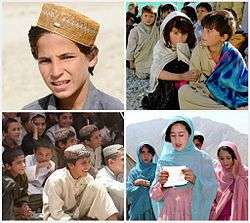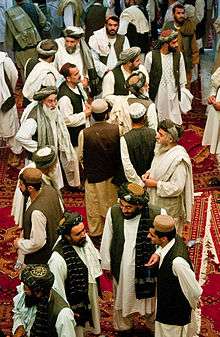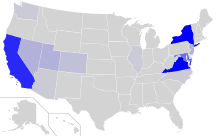Pashtun diaspora
| Total population | |
|---|---|
| (Approx. 49 million (2009)[1]) | |
| Regions with significant populations | |
| 30,699,036 (2015)[2] | |
| 13,750,117 (2008)[3] | |
| 338,315 (2009)[4] | |
| 138,554 (2010)[5] | |
| 110,000 (1993)[6] | |
| 100,000 (2009)[7] | |
| 37,800 (2012)[8] | |
| 26,000 (2006)[9] | |
| 13,000 (2009)[10] | |
| 9,800 (2002)[11] | |
| 8,154 (2006)[12] | |
| 5,500 (2008) | |
| 4,000 (1970)[6] | |
| Languages | |
|
Pashto Urdu, Dari and English as second languages | |
| Religion | |
|
Islam (Sunni) with small Shia minority | |
Pashtun diaspora refers to ethnic Pashtuns who live outside of their traditional homeland, which is south of the Hindu Kush mountains in Afghanistan and west of the Indus River in Pakistan.[13] Pakistan is home to the largest Pashtun community. Smaller populations of Pashtuns are found in the European Union, North America, Australia and other parts of the world. They may also be found in the Middle East, particularly in the United Arab Emirates, Iran, Oman, Saudi Arabia, Kuwait, Qatar and Bahrain. In Northern India, there are communities of Indians who trace their origins to the traditional Pashtun homeland.
The Pashtun ethnic group also known as Pathan are believed to have settled in the vast Pashtunistan[14][15] tribal region in the first millennium C.E., between the Hindu Kush mountains and the Indus River. According to Ethnologue, they currently number around 50 million[1] but some sources give slightly lower or higher figures.[16][17][18] In the Indian subcontinent, the group is usually referred to as Pathan.
Native land

Afghanistan
The ethnonym Afghan has been historically used since the 3rd century AD to refer to the Pashtuns, and is now used to describe every citizen of Afghanistan. Pashtuns make up the largest ethnic group in Afghanistan, comprising 42–60% [19][20] of the total Afghan population. Approximately 1.7 million Afghan refugees live in neighboring Pakistan. The majority of them are Pashtuns who were born in that country.[21]
The Pashtuns are scattered all over Afghanistan, they can be found in almost every province of the country.[22] Kandahar is the second largest city in Afghanistan and a stronghold of the Pashtun culture. The city of Lashkar Gah in the south, Farah in the west, Jalalabad in the east, and Kunduz in the north are other prominent cultural centres whose populations are predominantly Pashtun. Kabul and Ghazni each have at least 25% Pashtun while Herat and Mazar-i-Sharif each has at least 10%.[23]
Pakistan
Pashtun tribes make up the second largest ethnic group in Pakistan, comprising over 25%.[2][24] They form the majority ethnic group in the province of Khyber Pakhtunkhwa, the Federally Administered Tribal Areas (FATA) areas, and northern Balochistan.
With as many as 7 million by some estimates, the city of Karachi in Sindh Province hosts the largest concentration of urban Pashtuns population in the world[25][26] Some important Pashtun cities of Pakistan include: Peshawar, Quetta, Zhob, Loralai, Killa Saifullah, Swat, Mardan, Charsada, Mingora, Bannu, Parachinar, and Swabi.
The following delineates the Pashtun population in the provinces of Pakistan:
| Province | Pashtuns |
|---|---|
| 26 million | |
| 5.5 million | |
| |
10 million[25] |
| 5.5 million | |
| |
9 million |
| 350,000 | |
| 450,000 | |
| 57.7[2][24] |
Smaller Pashtun communities outside of Khyber Pakhtunkhwa can be found in the districts of Attock and Mianwali in Punjab. These and other communities of Pashtun ancestry are often referred to as the Punjabi Pashtun. There are also large communities of Punjabi-Pashtuns Such as Niazi and others lives in Khanewal, Kasur, and other larger communities have settled around Multan which was formerly part of the Durrani Empire. Pathan community lives in different district of Azad Kashmir. Mainly they are being settled in districts of Poonch, Sudhnuti and Bagh. In Poonch and Sudhnuti they constitute more than 70% population of district. Kashmiri Pashtuns mainly consists of Sadozai tribe which are locally known as Sudhan. Approximate population of Sadozai,s in AJK is 1 million. Sadozai tribe has a strong hold in Rawalakot city in Azad Kashmir. Small no of other pashtun tribes in Kashmir which include Durrani, Tareen, Lodhi, Yousafzai Shinwary and Afridi tribes which extends from Pakistan Occupied Kashmir to India's Jammu & Kashmir. They speak local languages.
In addition to this, some Urdu-speaking communities in Pakistan trace their ancestry to the ancient Pashtun regions of Afghanistan and Khyber Pakhtunkhawa. Some identify themselves as Bangash, Yousefzai, Ghouri and Durrani. Additionally, a significant number of descendants of Rohillas migrated to Pakistan after the independence of Pakistan in 1947.
Notable people
India
 |
| Part of a series on |
| Pashtuns |
|---|
| Kingdoms |
| Religion |
India, as a British colony, once had a large Pashtun population roughly equal to that of Afghanistan, mostly concentrated in what were then the British Indian provinces of the North-West Frontier Province and Baluchistan. In Rohilkhand, they made large settlements subsequent to 14th century and prior to the 20th century. In fact, according to Encyclopædia Britannica, the number of Pashtuns in all of India was nearly 31 million, but the speakers of Pashto numbered less than 14 million.[27] Most of this population was allotted, along with its respective provinces, to Pakistan after the independence in 1947. Today the Pashtuns in India can be divided into those who speak Pashto and those who speak Urdu and other regional languages, the Urdu speaking group being the biggest.[28]
Pashto-speaking communities
There are a large number of Pashto-speaking Pakhtuns in the Indian state of Jammu and Kashmir.[29] Although their exact numbers are hard to determine, it is at least in excess of 100,000 for it is known that in 1954 over 100,000 nomadic Pakhtuns living in Kashmir Valley were granted Indian citizenship.[30] Today jirgas are frequently held.[31] Those settled and living in the Kashmir Valley speak Pashto, and are found chiefly in the southwest of the valley, where Pashtun colonies have from time to time been founded. The most interesting are the Kukikhel Afridis of Dramghaihama, who retain all the old customs and speak Pashto. They wear colorful dress and carry swords and shields. The Afridis and the Machipurians, who belong to the Yusufzai tribe, are liable to military service, in return for which they hold certain villages free of revenue. The Pashtuns chiefly came in under the Durranis, but many were brought by Maharajah Gulab Singh for service on the frontier.[32] Pashto is also spoken in two villages, Dhakki and Changnar (Chaknot), located on the Line of Control in Kupwara District.[33] In response to demand by the Pashtun community living in the state, Kashir TV has recently launched a series of Pushto-language programs.[34]
A further small, scattered Pashtun population still exists in some major cities of India with large Muslim populations, with the majority of Pashto-speaking individuals residing in the states of Delhi and Uttar Pradesh India; who also have adopted local languages of the respective areas they live in, as their second language.[35][36] These Pathans, numbering around 14,161,[37][38] have retained the use of the Pashto language and are still able to speak and understand it. This is partially because until recently, most of these Indian Pashtuns were able to travel to Pakhtunkhwa, Pakistan.[39]
Urdu-speaking communities
The larger number of people claiming Pashtun ancestry in India are Urdu-speaking. Despite the loss of most of the Raj-era Pashtun population, India still has a large community of Urdu-speaking Muslims who trace their ancestry to ancient Pashtun invaders and settlers. They are often referred by the Hindustani pronunciation of the word Pashtun, "Pathan".
Major Indian Pathan tribes lived in the following areas. While many persons belonging to these tribes moved to the Afghan-Pakistan border, others chose to stay and thus, descendants of these tribes still reside in the parts of India listed below:[40]
- Tareens or Tarins, properly, in Sarai Tareen, a small town in the city Sambhal of Uttar Pradesh
- Kheshgis, Barakzais, Yousafzais and Momands in Khurja, a small town in District Bulandshahre, which lies in close proximity to New Delhi. Pathans in Khurja never marry outside their clan and this led to the preservation of their blue blood. Their alliance is with the Pathans of Bara-Basti (12 villages of pathans belonging to specific tribe in the district bulandshahre). Kheshgi are the most prominent tribe in this area and are only exclusive to Khurja only after KPK and Afghanistan.
- Rohillas in the Rohilkhand region of Uttar Pradesh
- Bangashes in Farrukhabad District in Uttar Pradesh and the towns of Kasganj and Kaimganj of Etah District
- Dilazaks in Village Shahjahanpur in Meerat ghar road Uttar Pradesh, Dilazak in Andhra Pradesh, Bari in Rajistan, Jalandhar (Punjab), Azeem Khail(Pathan Kot) Jammu and Kashmir and West Bengal.
- Marwats in Aurangabad in Maharashtra, Azamgarh in Uttar Pradesh and Bhopal
- Yousafzais in Baroda in Gujarat, and Bhopal in Madhya Pradesh
- Tonkia Pathan, a community mainly of Yousafzai descent found in Tonk, and other districts of Rajasthan
- Sorgar community of Rajasthan also claims Pashtun ancestry.
- Lodis and Suris of North India
- Lodis, Yousafzai and Suris of Bihar
- Pathans of Gujarat are a distinct community within the larger community of the Pathans of India. They belonge mainly to the Babi (a.k.a. Babai in Pakistan/Afghanistan), Lohani, Mandori, Yousafzai and Zadran tribes.
It is significant to note that a large part of above Pathan diaspora have naturalized themselves in the local culture over the centuries.
The term "Pathan" does not refer exclusively and specifically to these Indian Pashtun descendants. Historically the term was used mainly to refer to Pashtuns in general by mainstream Indians Muslims included. Most Pashtuns, however, find the term to be insensitive and prefer to be called by their native label.
Indians of Pashtun ancestry
- Zakir Hussain, President of India from 1967 to 1969[43]
- Shahrukh Khan, Bollywood superstar in Indian films[41][42]
- Madhubala, Bollywood actress between the 1940s and 1960s
- Feroz Khan, Bollywood actor during the 1960s, 1970s and 1980s
- Saif Ali Khan, Bollywood actor of Pashtun descent
- Parveen Babi, Bollywood actress during the 1970s and 1980s
- Salman Khan, Bollywood actor of Pashtun descent
- Salim Khan, Salman Khan's father
- Kader Khan, Bollywood actor
- Zarine Khan, Bollywood actress
Many Pashtuns worked in the Indian independence movement. While many supported the Muslim League's demand for Pakistan, some Pashtuns opposed it in favor of a united and secular India, especially members of the Indian National Congress. These included Khan Abdul Ghaffar Khan, his son Khan Wali Khan, Indian diplomat Mohammed Yunus, Pakistani opposition leader Mufti Mahmud and Balochistan-based Pashtun leader Abdul Samad Achakzai. Also among the Pashtuns in India are students from Afghanistan who are in India to obtain a quality education, including President of Afghanistan Hamid Karzai[44] and Kabuliwallah Pashtuns who are doing business in India.[45] In addition, India has a large number of Hindu and Sikh refugees from Afghanistan who are fluent in Pashto, and Dari.[46]
Pashtuns in the Middle East
Hundreds of thousands of Pasthuns serving as migrant workers reside in the Middle East, particularly in the United Arab Emirates, Saudi Arabia, Qatar, Kuwait, Oman and other Arab countries.[47] Many of them are involved in the transport business, while others are employees of construction companies.
Over 100,000 Pashtuns live in Iran as citizens of that country and a further sizable number live among the Afghan refugees. The Pashtuns there are mainly concentrated in the Afghan-Iran border, in the South Khorasan Province of Iran.[6]
About 300,000 Pashtuns migrated to the Gulf Countries between 1976 and 1981, representing 35% of Pakistani immigrants.[47]
Pashtuns in Europe
Many Pashtuns have migrated from their homeland in South/Central Asia to Europe.
United Kingdom
The United Kingdom is home to some 100,000 Pashtuns,[48] making it one of the most populous overseas Pashtun communities in the world and the most populous one in the West. Pashtun diaspora in UK have made their presence felt through their restaurants with traditional names like Bab-eKhyber, Hujra, Kabuli pulao etc. and Music. Its one of the most vibrant Pashtun diaspora in the west.[49]
Pashtuns in other parts of the world
United States

Pashtuns have been present in California at least since agricultural labor was imported in the early 20th century. Since the late 1970s and onwards, Pashtuns began immigrating to the USA in large numbers and are well established there. Pashtuns in the United States are famous for running top Afghan cuisine restaurants[50][51][52] and as owners of the fast-food restaurant chain Kennedy Fried Chicken that is based in New York City.
Canada
1,690 persons characterised their ethnicity as "Pashtun" in Canada's 2006 census.[53] However, in question 17 of Canada's Statcan census form[54] most Pashtuns don't put their ethnicity as Pashtuns but rather Afghan or Pakistani.
Pashtuns concentrate in regions with large Afghan and Pakistani communities. Interestingly, there are regions in southern Ontario with a large Pashtun diaspora of Pakistani nationality, living Afghan communities with Dari speakers instead of Pashto speakers, causing a large polarization of the word "Afghan", especially irredentist disputes claiming Pakistani Pashtun communities as Afghan nationals.
Australia
In the latter part of the 19th century several thousand men from Afghanistan, Baluchistan, Kashmir, Sind, Rajasthan, Egypt, Persia, Turkey and Punjab, but collectively known as "Afghans", were recruited during the initial British development of the Australian Outback, especially for the operation of camel trains in desert areas.[55] These consisted of men who were not allowed to bring their families with them, many married local Aborigines and are now known as Ghans.[56] During the 1980s and 90s, Pashtuns began settling in Perth, Melbourne, Sydney and other major cities of Australia.
Southeast Asia
Since the early 1900s there have been many generations of Pashtuns who migrated from Afghanistan, Pakistan and the tribal areas of Pakistan (Khyber Pakhtunkhwa). Pashtun settlements in Thailand have been common throughout the provinces. There is even a Thai-Pashtun Friendship Association. Because the Pashtuns are fiercely independent, they often are well treated and respected by the Thai locals. Countries like Cambodia, Laos, Indonesia and Malaysia also have similar cases of Pashtun settlements.
East Asia
There may be some Pashtun communities living in parts of China, Taiwan and Japan.
Guyana and Suriname
Some people living in Guyana and Suriname claim to be of Afghan descent. Most of them moved to South American countries during the Indian immigration.[57]
Latin America
Many Pashtuns from Afghanistan came to Argentina, Brazil, Chile, Panama, Colombia, Paraguay and Peru as refugees during the Soviet invasion of Afghanistan in 1981 and during the internal Afghan conflicts in 1995–1996
See also
- Pathans of Punjab
- Pathans of Rajasthan
- Pashtun people
- Pashtun tribes
- Pashtun culture
- Pashtunistan
- Pakhtunkhwa
- Rohilkhand
- Rohilla
References
- 1 2 "Pashto, Northern". SIL International. Ethnologue: Languages of the World. June 2010. Retrieved 2010-09-18.
Ethnic population: 49,529,000 possibly total Pashto in all countries.
- 1 2 3 "Pakistan population: 187,342,721 [Pashtun (Pathan) 15.42%]". The World Factbook. Central Intelligence Agency (CIA). 2012. Retrieved 2012-02-10.
- ↑ http://www.umsl.edu/services/govdocs/wofact2008/geos/af.html
- ↑ "United Arab Emirates: Demography" (PDF). Encyclopædia Britannica World Data. Encyclopædia Britannica Online. Retrieved 15 March 2008.
- ↑ 42% of 200,000 Afghan-Americans = 84,000 and 15% of 363,699 Pakistani-Americans = 54,554. Total Afghan and Pakistani Pashtuns in USA = 138,554.
- 1 2 3 "Ethnologue report for Southern Pashto: Iran (1993)". SIL International. Ethnologue: Languages of the World. Retrieved 5 May 2012.
- ↑ Maclean, William (10 June 2009). "Support for Taliban dives among British Pashtuns". Reuters. Retrieved 6 August 2009.
- ↑ Relations between Afghanistan and Germany: Germany is now home to almost 90,000 people of Afghan origin. 42% of 90,000 = 37,800
- ↑ "Ethnic origins, 2006 counts, for Canada". 2.statcan.ca. 2006. Retrieved 17 April 2010.
- ↑ "Abstract of speakers' strength of languages and mother tongues – 2001". Census of India. 2001. Retrieved 17 March 2008.
- ↑ "Perepis.ru". perepis2002.ru (in Russian).
- ↑ "20680-Ancestry (full classification list) by Sex – Australia" (Microsoft Excel download). 2006 Census. Australian Bureau of Statistics. Retrieved 2 June 2008. Total responses: 25,451,383 for total count of persons: 19,855,288.
- ↑ "Pashtun". Encyclopædia Britannica. Retrieved 10 September 2010.
- ↑ "Afghan and Afghanistan". Abdul Hai Habibi. alamahabibi.com. 1969. Retrieved 24 October 2010.
- ↑ Muhammad Qasim Hindu Shah (Firishta). "History of the Mohamedan Power in India". Persian Literature in Translation. Packard Humanities Institute. Retrieved 10 January 2007.
- ↑ Penzl, Herbert; Sloan, Ismail (2009). A Grammar of Pashto a Descriptive Study of the Dialect of Kandahar, Afghanistan. Ishi Press International. p. 210. ISBN 0-923891-72-2. Retrieved 2010-10-25.
Estimates of the number of Pashto speakers range from 40 million to 60 million...
- ↑ "Pashto". Omniglot.com. Retrieved 2010-10-25.
The exact number of Pashto speakers is not known for sure, but most estimates range from 45 million to 55 million.
- ↑ Thomson, Gale (2007). Countries of the World & Their Leaders Yearbook 08. 2. European Union: Indo-European Association. p. 84. ISBN 0-7876-8108-3. Retrieved 2010-10-25.
- ↑ "Afghan Population: 31,108,077 (July 2013 est.) [Pashtun = 42%]". Central Intelligence Agency (CIA). The World Factbook. Retrieved 7 June 2013.
- ↑ See:
- "Ethnic groups". BBC News. Retrieved 7 June 2013.
Pashtun: Estimated to comprise more than 45% of the population, the Pashtuns have been the dominant ethnic group in Afghanistan.
- Janda, Kenneth; Berry, Jeffrey M.; Goldman, Jerry (2008). The Challenge of Democracy: Government in America (9 ed.). Cengage Learning. p. 46. ISBN 0-618-81017-X. Retrieved 2010-08-22.
- "Afghanistan's complex ethnic patchwork". The Asian Wall Street Journal. Tehran Times. 10 March 2011. Retrieved 20 April 2012.
- "Pathans". Faqs.org. 2003. Retrieved 2010-09-20.
- "About Afghanistan – Ethnic Divisions". Retrieved 2010-09-24.
- Christensen, Asger (1995). Aiding Afghanistan: the background and prospects for reconstruction in a fragmented society. NIAS Press. p. 46. ISBN 87-87062-44-5. Retrieved 2010-09-24.
- Congressional Record. Government Printing Office. p. 10088. Retrieved 2010-09-24.
- Taylor, William J. Jr.; Kim, Abraham (2000). Asian Security to the Year 2000. DIANE Publishing. p. 58. ISBN 1-4289-1368-8. Retrieved 2010-09-24.
- Brown, Keith; Ogilvie, Sarah (2009). Concise encyclopedia of languages of the world. Elsevie. p. 845. ISBN 0-08-087774-5. Retrieved 2010-09-24.
Pashto, which is mainly spoken south of the mountain range of the Hindu Kush, is reportedly the mother tongue of 60% of the Afghan population.
- Hawthorne, Susan; Winter, Bronwyn (2002). 11 September 2001: feminist perspectives. Spinifex Press. p. 225. ISBN 1-876756-27-6. Retrieved 2010-09-24.
Over 60 percent of the population in Afghanistan is Pashtun...
- "The ethnic composition of afghanistan in different sources". Retrieved 22 April 2012.
- "Ethnic groups". BBC News. Retrieved 7 June 2013.
- ↑ "PAKISTAN: Tolerance wanes as perceptions of Afghan refugees change". Irin. 27 February 2012. Retrieved 3 March 2012.
- ↑ "District Development Plans (DDP)". Government of Afghanistan and United Nations Development Programme (UNDP). Ministry of Rural Rehabilitation and Development. Retrieved 2012-11-28.
- ↑ "Ethnic map of Afghanistan" (PDF). Thomas Gouttierre, Center For Afghanistan Studies, University of Nebraska at Omaha; Matthew S. Baker, Stratfor. National Geographic Society. 2003. Retrieved 24 October 2010.
- 1 2 "Pakistan Index: Tracking Variables of Reconstruction & Security" (PDF). Brookings Institution. 29 December 2011. p. 13. Retrieved 25 January 2012.
- 1 2 Obaid-Chinoy, Sharmeen (17 July 2009). "Pakistan: Karachi's Invisible Enemy City potent refuge for Taliban fighters". PBS. Retrieved 20 September 2010.
- ↑ "In a city of ethnic friction, more tinder". The National. 24 August 2009. Retrieved 2010-08-24.
- ↑ "Pathan". Encyclopædia Britannica Eleventh Edition. Retrieved 2007-06-07.
- ↑ Alvi, Shams-ur-Rehman (11 December 2008). "Indian Pathans to broker peace in Afghanistan". Hindustan Times. Retrieved 3 May 2015.
- ↑ "Special focus on Gujjars, Paharis: CM". Daily Excelsior. Retrieved 2009-08-22.
- ↑ "Pakhtoons in Kashmir". Chennai, India: The Hindu. 20 July 1954. Retrieved 2009-08-22.
- ↑ "Justice rolls in Kashmir, Afghan-style". The Telegraph. Retrieved 2009-08-22.
- ↑ "Saiyids, Mughals, Pashtuns and Galawans". OPF. Archived from the original on 15 May 2007. Retrieved 2007-06-07.
- ↑ "A First Look at the Language of Kundal Shahi in Azad Kashmir" (PDF). SIL International. Retrieved 2009-06-11.
- ↑ http://www.tribuneindia.com/2000/20001207/j&k.htm
- ↑ "Pathan". Isa-Masih in Lucknow. Retrieved 2007-02-17.
- ↑ "Rampur". Christopher Buyers. Retrieved 2007-06-07.
- ↑ "Phonemic Inventory of Pashto" (PDF). CRULP. Retrieved 2007-06-07.
- ↑ Abstract of speakers’ strength of languages and mother tongues – 2001, Census of India (retrieved 17 March 2008)
- ↑ "Study of the Pathan Communities in four States of India". Khyber. Retrieved 2007-06-07.
- ↑ "Pashto Language & Identity Formation" (PDF). Contemporary South Asia, July 1995, Vol 4, Issue 2, p151,20 (Khyber). Retrieved 2007-06-07.
- 1 2 "The Rediff Interview / Shah Rukh Khan". Rediff. Retrieved 2006-06-05.
- 1 2 "Shahrukh Khan is Afghan". Afghan Buzz. Retrieved 2009-06-07.
- ↑ "Dr. Zakir Hussain". Glorious India. Retrieved 2006-06-05.
- ↑ "Afghan students have special attraction towards Himachal University". Indians in Thailand. Retrieved 2007-06-07.
- ↑ "The Kabuliwallahs of Ballimaran". Chennai, India: The Hindu. 24 October 2005. Retrieved 2007-06-07.
- ↑ "No Place to Turn: Afghan Refugees in New Delhi". Human Rights Documentation Centre. Retrieved 2007-06-07.
- 1 2 Jaffrelot, Christophe (2002). Pakistan: nationalism without a nation?. Zed Books. p. 27. ISBN 1-84277-117-5. Retrieved 2010-08-22.
- ↑ "FEATURE – Support for Taliban dives among British Pashtuns". Reuters. 10 June 2009.
- ↑ "The Other Languages of England", British Journal of Educational Studies, Vol. 34, No. 3 (October 1986), pp. 288–289.
- ↑ Helmand – Baltimore, Maryland
- ↑ Helmand – San Francisco, California
- ↑ Helmand – Cambridge, Massachusetts
- ↑ 2006 Census of Canada: Topic-based tabulations
- ↑ http://www12.statcan.ca/IRC/english/guide_e.pdf
- ↑ australia.gov.au > About Australia > Australian Stories > Afghan cameleers in Australia Accessed 8 May 2014.
- ↑ "Afghan histories in Australia." Dulwich Centre. Retrieved 6 January 2010.
- ↑ "Afghans of Guyana". Wahid Momand. Afghanland.com. 2000. Retrieved 2007-01-18.
Bibliography
- Ahmad, Aisha; Roger Boase. Pashtun Tales from the Pakistan-Afghan Frontier: From the Pakistan-Afghan Frontier. Saqi Books, 2003. ISBN 0-86356-438-0.
- Ahmed, Akbar S. 1976. Millennium and charisma among Pathans: a critical essay in social anthropology. Routledge & Kegan Paul, 1980. ISBN 0-7100-0547-4.
- Ahmed, Akbar S. Pukhtun economy and society: traditional structure and economic development in a tribal society. Routledge & Kegan Paul, 1980. ISBN 0-7100-0389-7.
- Caroe, Olaf. The Pathans: 500 B.C.-A.D. 1957. MacMillan, 1964. ISBN 0-19-577221-0.
- Dani, Ahmad Hasan. Peshawar: Historic city of the Frontier. Khyber Mail Press, 1969. ISBN 969-35-0554-9.
- Docherty, Paddy. The Khyber Pass: A History of Empire and Invasion. Union Square Press, 2008. ISBN 0-571-21977-2.
- Dupree, Louis. Afghanistan. Princeton University Press, 1973. ISBN 0-691-03006-5.
- Elphinstone, Mountstuart (1815). An account of the kingdom of Caubul, and its dependencies in Persia, Tartary, and India: comprising a view of the Afghaun nation, and a history of the Dooraunee monarchy. Longman, Hurst, Rees, Orme and Brown, 1815.
- Habibi, Abdul Hai. Afghanistan: An Abridged History. Fenestra Books, 2003. ISBN 1-58736-169-8.
- Hopkirk, Peter. The Great Game: the struggle for empire in central Asia Kodansha Globe; Reprint edition. Kodansha International, 1994. ISBN 1-56836-022-3.
- Nichols, Robert. A history of Pashtun migration, 1775–2006. Oxford University Press, 2008. ISBN 0-19-547600-X.
- Vogelsang, Willem. The Afghans. Wiley-Blackwell, 2002. ISBN 0-631-19841-5.
- Wardak, Ali. Jirga – A Traditional Mechanism of Conflict Resolution in Afghanistan, 2003, online at UNPAN (the United Nations Online Network in Public Administration and Finance).
- Weiner, Myron; Ali Banuazizi. The Politics of social transformation in Afghanistan, Iran, and Pakistan. Syracuse University Press, 1994. ISBN 0-8156-2609-6.
- Weinreich, Matthias. "We are here to stay": Pashtun migrants in the Northern Areas of Pakistan. Klaus Schwarz, 2009. ISBN 3-87997-356-3.

